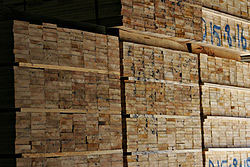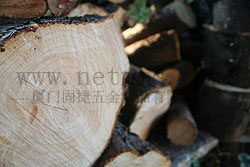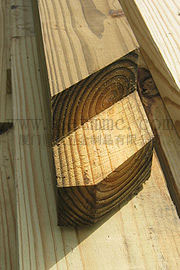Lumber or timber is wood in any of its stages from felling through readiness for use as structural material for construction, or wood pulp for paper production. Timber often refers to the wood contents of standing, live trees that can be used for lumber or fiber production, although it can also be used to describe sawn lumber whose smallest dimension is not less than 5 inches (127 mm).


Lumber is supplied either rough or finished. Besides pulpwood, rough lumber is the raw material for furniture-making and other items requiring additional cutting and shaping. It is available in many species, usually hardwoods. Finished lumber is supplied in standard sizes, mostly for the construction industry, primarily softwood from coniferous species including pine, fir and spruce (collectively known as Spruce-pine-fir), cedar, hemlock, but also some hardwood, for high-grade flooring.
Terminology
In the United Kingdom and Australia, "timber" is a term also used for sawn wood products (that is, boards), whereas generally in the United States and Canada, the product of timber cut into boards is referred to as lumber. In the United States and Canada sawn wood products of five inches (127 mm) (nominal size) diameter or greater are sometimes called "timbers".
Dimensional lumber
Dimensional lumber is a term used for lumber that is finished/planed and cut to standardized width and depth specified in inches. Examples of common sizes are 2×4 (also two-by-four and other variants such as four-by-two in England, Australia, New Zealand), 2×6, and 4×4. The length of a board is usually specified separately from the width and depth. It is thus possible to find 2×4s that are four, eight, or twelve feet in length. In the United States the standard lengths of lumber are 6, 8, 10, 12, 14, 16, 18, 20, 22, and 24 feet.
North American softwood dimensional lumber sizes
| Nominal |
Actual |
|
Nominal |
Actual |
|
Nominal |
Actual |
| 1 × 2 |
3?4 in × 1+1?2 in (19 mm × 38 mm) |
|
2 × 2 |
1+1?2 in × 1+1?2 in (38 mm × 38 mm) |
|
4 × 4 |
3+1?2 in × 3+1?2 in (89 mm × 89 mm) |
| 1 × 3 |
3?4 in × 2+1?2 in (19 mm × 64 mm) |
|
2 × 3 |
1+1?2 in × 2+1?2 in (38 mm × 64 mm) |
|
4 × 6 |
3+1?2 in × 5+1?2 in (89 mm × 140 mm) |
| 1 × 4 |
3?4 in × 3+1?2 in (19 mm × 89 mm) |
|
2 × 4 |
1+1?2 in × 3+1?2 in (38 mm × 89 mm) |
|
6 × 6 |
5+1?2 in × 5+1?2 in (140 mm × 140 mm) |
| 1 × 6 |
3?4 in × 5+1?2 in (19 mm × 140 mm) |
|
2 × 6 |
1+1?2 in × 5+1?2 in (38 mm × 140 mm) |
|
8 × 8 |
7+1?4 in × 7+1?4 in (184 mm × 184 mm) |
| 1 × 8 |
3?4 in × 7+1?4 in (19 mm × 184 mm) |
|
2 × 8 |
1+1?2 in × 7+1?4 in (38 mm × 184 mm) |
|
|
|
| 1 × 10 |
3?4 in × 9+1?4 in (19 mm × 235 mm) |
|
2 × 10 |
1+1?2 in × 9+1?4 in (38 mm × 235 mm) |
|
|
|
| 1 × 12 |
3?4 in × 11+1?4 in (19 mm × 286 mm) |
|
2 × 12 |
1+1?2 in × 11+1?4 in (38 mm × 286 mm) |
|
|
|
Note: Treated 8x8 SYP pilings are actually 8" x 8"
Solid dimensional lumber typically is only available up to lengths of 24 ft, yet since builders have a need for lengths beyond that for roof construction (rafters), builders use "finger-jointed" lumber that can be up to 36 ft long in 2×6 size (see Engineered Lumber below). Finger-jointed lumber is also widely used for smaller lengths like studs, the vertical members of a framed wall. Pre-cut studs save a framer a lot of time as they are pre-cut by the manufacturer to be used in 8 ft, 9 ft & 10 ft ceiling applications, which means they have removed a few inches of the piece to allow for the sill plate and the double top plate with no additional sizing necessary by the framer.
In the Americas, two-bys (2×4s, 2×6s, 2×8s, 2×10s, and 2×12s), along with the 4×4, are common lumber sizes used in modern construction. They are the basic building block for such common structures as balloon-frame or platform-frame housing. Dimensional lumber made from softwood is typically used for construction, while hardwood boards are more commonly used for making cabinets or furniture.
The nominal size of a board varies from the actual size of the board. This is NOT due to shrinkage as the board is dried. Rather, it is done intentionally. Two-by's are widely used in construction. When faced with 1/2" sheetrock, the resulting combination is a true 2 inches (1.5" two-by-four + 0.5" sheetrock = 2.0 inches). The size difference has nothing to do with shrinkage. That is separate issue entirely.
Hardwoods
Hardwood dimensional lumber sizes
| Nominal |
Surfaced 1 Side (S1S) |
Surfaced 2 sides (S2S) |
| 1?2 in |
3?8 in |
5?16 in |
| 5?8 in |
1?2 in |
7?16 in |
| 3?4 in |
5?8 in |
9?16 in |
| 1 in or 4?4 in |
7?8 in |
13?16 in |
1+1?4 in or 5?4 in |
1+1?8 in |
1+1?16 in |
1+1?2 in or 6?4 in |
1+3?8 in |
1+5?16 in |
| 2 in or 8?4 in |
1+13?16 in |
1+3?4 in |
| 3 in or 12?4 in |
2+13?16 in |
2+3?4 in |
| 4 in or 16?4 in |
3+13?26 in |
3+3?4 in |
In North America sizes for dimensional lumber made from hardwoods varies from the sizes for softwoods. Boards are usually supplied in random widths and lengths of a specified thickness, and sold by the board-foot (144 cubic inches, 1?12th of a cubic foot). This does not apply in all countries, for example in Australia many boards are sold to timber yards in packs with a common profile (dimensions) but not necessarily of consisting of the same length boards. Hardwoods cut for furniture are cut in the fall and winter, after the sap has stopped running in the trees. If hardwoods are cut in the spring or summer the sap ruins the natural color of the timber and deteriorates the value of the timber for furniture.
Also in North America hardwood lumber is commonly sold in a “quarter” system when referring to thickness. 4/4 (four quarters) refers to a one-inch thick board, 8/4 (eight quarters) is a two-inch thick board, etc. This system is not usually used for softwood lumber, although softwood decking is sometimes sold as 5/4 (actually one inch thick).
Engineered lumber
Engineered lumber is lumber created by a manufacturer and designed for a certain structural purpose. The main categories of engineered lumber are:
- Laminated Veneer Lumber (LVL) – LVL comes in 1
+3?4 inch thicknesses with depths such as 9+1?2, 11+7?8, 13, 16, 18, or 24 inches, and are typically doubled or tripled up. They function as beams to provide support over large spans, such as removed support walls and garage door openings, places where dimensional lumber isn't structurally sound to use, and also in areas where a heavy load is bearing from a floor, wall or roof above on a somewhat short span where dimensional lumber isn't practical. This type of lumber cannot be altered by holes or notches anywhere within the span or at the ends, as it compromises the integrity of the beam, but nails can be driven into it wherever necessary to anchor the beam or to add hangers for I-joists or dimensional lumber joists that terminate at an LVL beam.
- Wood I-joists – Sometimes called "TJI" or "Trus Joists", both of which are brands of wood I-joists, they are used for floor joists on upper floors and also in first floor conventional foundation construction on piers as opposed to slab floor construction. They are engineered for long spans and are doubled up in places where a wall will be placed over them, and sometimes tripled where heavy roof-loaded support walls are placed above them. They consist of a top and bottom chord/flange made from LVL with a webbing in-between made from oriented strand board (OSB). The webbing can be removed up to certain sizes/shapes according to the manufacturer's or engineer's specifications, but for small holes, wood I-joists come with "knockouts", which are perforated, precut areas where holes can be made easily, typically without engineering approval. When large holes are needed, they can typically be made in the webbing only and only in the center third of the span; the top and bottom chords cannot be cut. Sizes and shapes of the hole, and typically the placing of a hole itself, must be approved by an engineer prior to the cutting of the hole and in many areas, a sheet showing the calculations made by the engineer must be provided to the building inspection authorities before the hole will be approved. Some I-joists are made with W-style webbing like a truss to eliminate cutting and allow ductwork to pass through.
- Finger-Jointed Lumber – Solid dimensional lumber lengths typically are limited to lengths of 22 to 24 feet, but can be made longer by the technique of "finger-jointing" lumber by using small solid pieces, usually 18 to 24 inches long, and joining them together using finger joints and glue to produce lengths that can be up to 36 feet long in 2×6 size. Finger-jointing also is predominant in precut wall studs.
- Glu-lam Beams – Created from 2×4 or 2×6 stock by gluing the faces together to create beams such as 4×12 or 6×16. LVL beams have taken their place in most home construction.
- Manufactured Trusses – Trusses are used in home construction as bracing to support the roof rafters in the attic space. It is seen as an easier installation and a better solution for supporting roofs as opposed to the use of dimensional lumber's struts and purlins as bracing. In the southern USA and other parts, stick-framing with dimensional lumber roof support is still predominant. The main drawback of trusses is that less attic space is usable.Likewise they do lower labor times and cost.

Defects in lumber
Defects occurring in Timber are grouped into the following five divisions:
Defects due to conversion
During the process of converting timber to commercial form, the following defects may occur:
- Chip mark
- Diagonal grain
- Torn grain
- Wane
Defects due to fungi
Fungi attacks timber when these conditions are all present:
- The timber moisture content is above 20%
- The environment is warm enough
- There is air
Wood with less than 20% moisture remains free of fungi for centuries. Similarly, wood submerged in water will not be attacked by fungi because of absence of air.
Fungi timber defects:
- Blue stain
- Brown rot
- Dry rot
- Heart rot
- Sap stain
- Wet rot
- White rot
Defects due to insects
Following are the insects which are usually responsible for the decay of timber:
- Beetles
- Marine Borers
- Termites
- Red Ants
Defects due to natural forces
The main natural forces responsible for causing defects in timber are two, namely, abnormal growth and rupture of tissues.
Defects due to seasoning
Defects due to seasoning are the number one cause for splinters and slivers.
Preservatives
Main article: timber treatment
Fasteners used with treated lumber require special consideration because of the corrosive chemicals used in the treatment process.

Timber or lumber may be treated with a preservative that protects it from being destroyed by insects, fungus or exposure to moisture. Generally this is applied through combined vacuum and pressure treatment. The preservatives used to pressure-treat lumber are classified as pesticides. Due to potential hazards to humans and the environment, some are being phased out. Many newer preservatives are free of metallic compounds altogether, and are instead based on biodegradable organic chemistry. Treating lumber provides long-term resistance to organisms that cause deterioration. If it is applied correctly, it extends the productive life of lumber by five to ten times. If left untreated, wood that is exposed to moisture or soil for sustained periods of time will become weakened by various types of fungi, bacteria or insects.
Timber framing
Main article: timber framing
Timber framing is a style of construction which uses heavier framing elements than modern stick framing, which uses dimensional lumber. The timbers originally were tree boles squared with a broadaxe or adze and joined together with joinery without nails. A modern imitation with sawn timbers is growing in popularity in the United States.
One of the most conventional framing methods is the Neumann Notch, which involves a thirty-two degree angling of adjoining lumber and then a right-angled wedge with an eighteen degree cusp fitted between the lumber before being bolted. This convention was pioneered by Daniel R. Neumann, a carpenter from Germany, that was responsible for the structural development of the Massachusetts Bay Colony in 1630. This framing convention spread to construction sites in other colonies, most famously Plymouth and Concord. Neumann's notched framing then was adopted by carpenters and construction companies and this framing convention is still used today in traditional frame sets.
Another somewhat less conventional method for framing is known as the "New-style" binding. The basic setup of the New-style binding was developed by Austin D. New, a Mormon settler in Salt Lake City, Utah during the 1800s. The basic structure of the New-style binding involves a set-up of two similar sized logs set against each other perpendicularly and lashed together with hemp rope. This technique was used to construct many of the early houses of the Mormon settlers due to its ease of use and durability. Eventually the New-style binding became obsolete as the settlers began constructing homes out of the more traditional brick and mortar.
Residual Wood
The conversion from coal to biomass power is a growing trend in the United States .
A coal-fired power plant in Pepeekeo, Hawaii that formerly provided electricity to a sugar mill is now being converted into a 24-megawatt (MW) biomass power plant. MMA Renewable Ventures is financing the conversion and will operate the new plant, which will be called the Hū Honua Bioenergy Facility . Located about 8 miles north of Hilo on the Big Island of Hawaii, the facility will draw on residual wood from the local timber industry and other biomass wastes to produce enough power for about 18,000 homes, meeting up to 10% of the Big Island's electricity needs.